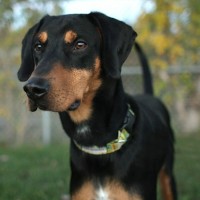Appearance of the Beagleman
|
| The Beagleman hybrid is a muscular, medium-sized dog with a broad chest and long, straight legs. The head is generally broad, and although it can be slightly rounded like the Beagle head, it is more often flat and somewhat wedge-shaped. Their eyes generally come in different shades of brown and can be either the round eyes of the Beagle or the almond-shaped eyes of the German Pinscher, and their ears tend to hang to the sides, whether set high or low on the head. While the German Pinscher's ears and tail are usually docked when young, this is not the case for the Beagleman, and they retain their floppy ears and long, straight tail. The Beagleman coat will be double-layered with a short, dense undercoat protected by a shorter, stiffer layer of fur that lies flat against the dog's body, and the outer coat often has the elegant or glossy look that is characteristic of the German Pinscher. Although there are many possible color variations that could appear with this crossbreed, the vast majority of these dogs are various shades of black, brown and beige, often with white markings. |
Temperament of the Beagleman
|
| This hybrid is family-oriented and does best if fully integrated into the family, however, these dogs can have very powerful jaws and any interactions with toddlers and young children must be carefully supervised. That said, they generally tend to adopt gentle, playful and loving behaviors towards children. The Beagle and German Pinscher can be stubborn, and the German Pinscher can sometimes adopt a dominant attitude, which can make the Beagleman difficult to train, despite their intelligence. |
Needs and activities of the Beagleman
|
| Cross-breeding the Beagle and the German Pinscher generally produces an intelligent, loyal animal that is also playful and affectionate. The Beagleman is less reserved with strangers than the German Pinscher, but their overall nature is more protective than the average Beagle, and they make good watchdogs. They are outgoing and friendly towards humans and tend to get on well with other dogs, however, they still retain the Beagle's strong hunting drive and may not be able to resist the pursuit of other fast-moving pets. |
Maintenance of the Beagleman
|
| Beagles and German Pinschers are easy-care dogs when it comes to grooming. Although they can be prone to a moderate amount of normal dog odor, it's not overwhelming and these dogs generally only need a bath every few months. Their short coats are not prone to tangling or matting, but brushing is necessary every few days to help remove loose hairs and distribute healthy oils throughout the coat, improving coat health and appearance. Dogs with floppy or hanging ears may be slightly predisposed to ear infections, and it's important to check and clean their ears regularly. |









 English (United Kingdom)
English (United Kingdom)